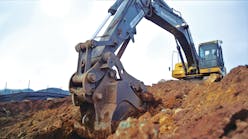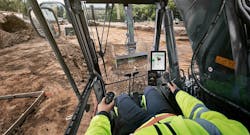This article first appeared in the July/August 2015 of Grading & Excavation Contractor.
Gaining a Competitive Edge
The construction industry is a competitive one. Those contractors who embrace telematics—and who use the systems’ full capabilities—can gain an edge, says Michael Reinhardt, telematics strategy manager with Morrow, GA-based Doosan Infracore Construction Equipment.
Contractors hate to see their machines go down for repairs. By using telematics systems to monitor their machines’ performance and health, contractors can reduce the odds that significant portions of their fleets will be out of service at any one time, says Reinhardt.
“Monitoring the health of the machines becomes an easier task,” says Reinhardt. “With these systems you are taking a proactive approach to making sure that machines stay healthy. You can solve issues before you are hit with downtime. Time is money for these guys. With a $200,000, $300,000 piece of equipment, the longer it is down, the more it costs you. With telematics, you can keep these machines up and running.”
The real test of the relationship between telematics and construction industry pros will come in the near future. The major manufacturers of grading and excavation equipment not only equip their machines with telematics systems, they also provide free subscriptions to these systems—free periods that usually run from three to six years.
So what happens when these subscriptions start running out? Will contractors renew them?
“We are already seeing some customers paying to renew expiring telematics subscriptions,” says Reinhardt. “Contractors are learning the benefits of these systems today. Telematics is becoming an important part of the job site.”
Reinhardt points to the number of expiring subscriptions that have been renewed within the past year. Many customers have paid to extend the telematics subscription beyond the initial free period. These contractors have seen how telematics can help them manage their job sites more efficiently and prolong the lives of their expensive equipment.
They want to provide their older equipment with these same remote-monitoring capabilities—and are willing to pay for the costs of doing so—because they’ve learned over time the positive impact telematics has on their bottom lines, explains Reinhardt. Telematics saves them enough money each year to quickly cover the costs of installing an older machine with the new technology, says Reinhardt.
One thing telematics doesn’t do is eliminate the need for skilled operators. Contractors still need to hire talented operators to run their graders and excavators. But telematics can make these talented operators even better at their jobs.
Reinhardt gives this example: Operators need to hit a vehicle’s regeneration button every so often to regenerate its diesel fuel, with today’s machines providing operators with an alert notifying them when it’s time to hit that button. Operators, though, might be tempted to instead hit the override button, turning off the alert and delaying the regeneration process, so that they can keep working. It’s only a matter of time, then, before the machine shuts down and starts the regeneration process by itself.
With telematics, fleet managers can track how often their operators are ignoring warning messages coming off of the machine, says Reinhardt. They can then talk with their operators about not ignoring these alerts and help coach them on the importance of taking action on those alerts to maintain the health of the machine. Through such monitoring, fleet managers can steadily improve the skills of all their operators, adds Reinhardt.
“If you have an operator who is less skilled, telematics won’t make them more skilled right away,” says Reinhardt. “But a fleet manager can see what is happening on a machine, which allows him to inquire about possible issues or identify needs for operator education.”
With all the benefits that telematics brings to contractors, what is keeping more operators and fleet managers from fully tapping the power of these systems that are already installed in their machines?
The biggest challenge lies in convincing operators and owners that these systems aren’t difficult to learn and master, says Richardson.
“The gains that you get from telematics solutions are great,” says Richardson. “There had been a fear from contractors about the complexity of using these systems in the past. That is changing, too, though. We have been working to make these systems easier to use, and they are much more intuitive today.”
This is paying off. So are the educational efforts that manufacturers are making to teach distributors, contractors, and fleet managers about how to use these systems for both monitoring vehicles and job progress, says Richardson.
“As the word spreads, people who aren’t using telematics are saying, ‘I’m actually missing out here,’” says Richardson. “It’s been a knowledge gap in the past. But now the word is spreading about all the useful information that these systems provide. It’s not just, ‘Where is my machine right now?’ Telematics provides data that owners can use for their accounting and business operations. It can provide them with tools to run their businesses more efficiently.”
A Bright Future
The growth in telematics use in the construction industry is happening quickly now. Dave Adams, product manager for telematics with the Shippensburg, PA, office of Volvo Construction Equipment, says that he’s seen a big increase in how important telematics has become to contractors in just the last two years.
This bodes well for the future, he says. As contractors become more comfortable with the technology, many are discovering that they no longer want to run their machines and their job sites without telematics. This greater acceptance on the part of contractors will pay a big role in boosting the telematics industry when the complete job site is monitored and decisions can be made immediately based off real time data.
“Telematics was more of a novelty earlier on,” says Adams. “Contractors thought it was just a vehicle location tool at first. But now they are asking us a lot of good questions. They’ve learned how they can use the data to improve their operations and improve efficiencies. It’s about saving money for them and improving situational awareness. And that’s what makes telematics today such an important tool for this industry.”









